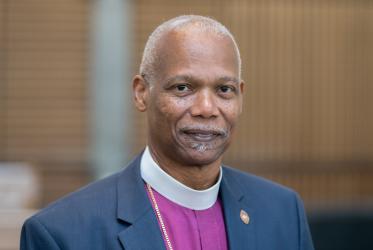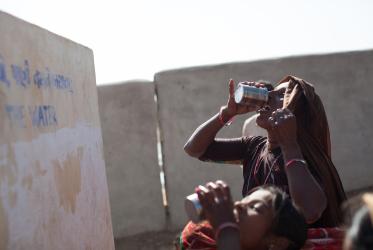Do you not know
that all of us who have been baptized into Christ Jesus
were baptized into his death?
Therefore we have been buried with him by baptism into death,
so that, just as Christ was raised from the dead
by the glory of the Father,
so we too might walk in newness of life.
Romans 6:3,4
Water has always been an instrument of both death and life. In the beginning the Spirit of God moved over the water, calling forth creation and life. Death came upon the earth in the form of a massive flood during Noah’s time. Hagar found a well in the wilderness that became saving water for her and her child Ishmael. Life and death, dying and rising, water and Spirit are foundational to the life of faith we share as baptized children of God.
The biblical stories of water reflect our present day reality and engagement with this basic element of life and death. Floods and typhoons today call to mind the biblical story of Noah. The fear of death by so many who do not have clean water to drink may bring to mind Hagar’s distress and resignation to what could have been her death and the death of her child. We must also remember that all life depends on water and the beauty of the earth is sustained and nourished by snow and rain. Bountiful harvests, water to wine, sacred baths, beautiful gardens, an abundant catch of fish, reflect the life giving nature of water we experience today and also find in scripture. These are but a few examples of the sacred connections that help us understand our participation in God’s never ending drama and how water is so sacred.
The Church consists of people born of water and the Spirit in baptism. Baptism is a journey only completed in death and therefore we are called to “live wet” or practice the faith we covenanted to live with God and one another throughout our lives.
When we intentionally make connections between all water and the water of baptism, we can then find the sacredness of every encounter with this basic element of life and death. On the other hand we may find the defilement of God’s sacredness when water is polluted, deprived to humans, used as a means of wealth, or used for torture.
As we journey through Lent toward the paschal mystery of Easter, a time where baptism and our death and resurrection in Christ is powerfully engaged, we can prepare ourselves by making connections to water and all life through intentional practices in worship. These connections then can help us “live wet” and be opportunities to practice our baptismal faith.
In the community where I live and practice the faith we use water in different parts of the liturgy to make connections between the baptismal life and the water we encounter each day. The prayers of thanksgiving for water include local creeks, rivers and streams by name. We pour water as we gather, to remind us of the sacredness of other places where we gather around water such as rivers, lakes, city fountains, and the waterfalls that are a beautiful part of our local landscape. Water is always poured during the confession rite as a reminder of God’s constant call to repentance so that destructive practices are put to death and where God’s Spirit is gracefully calling us to rise to new life.
During offering water poured and words spoken remind us to live into our baptism as living and holy sacrifices. We are reminded of how our most precious offering is a life that reflects God’s love and justice in the world.
As we are sent out of worship into the rest of our lives, we are encouraged to let every encounter with water remind us of all these things, making the deep connections to sacred living and being reminded of the sacredness of all water and all creation, for it is a matter of life and death.
Chip Andrus
Chip Andrus is a liturgical theologian and a singer/song-writer who is currently the pastor of First Presbyterian Church in Harrison, Arkansas.
Together we can make a difference:
-
Name the different sources of water and water bodies close to where you live. Give God thanks for them.
-
Next time you see water—like when it rains or you go to the river—remember God’s beauty and sustaining love all around us, and remember that you’re a baptized child of God.
-
Is it possible for you to organize a visit, e.g. with your Bible study group or a confirmation class, to one of the water sources, rivers, or lakes where you live? Consider going to a local water place and having a short service of thanksgiving for water.
-
Maybe there is also an opportunity to combine reflection with practical action, like a river clean-up?
Links to further information:
-
Read more about what it means to “live wet” and find many more ideas on how to integrate water as a constant reminder of our baptism in your own and your community’s life: www.calvin.edu/worship/stories/remembering_baptism.php (in English)




